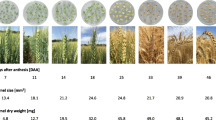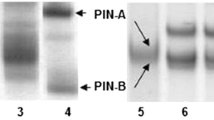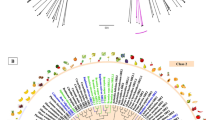Abstract
Oat kernels exhibit an extra-soft texture, a trait recently demonstrated to be largely modulated by starch-bound tryptophan-rich 2S proteins, the vromindolines. In this study, fractionation by two-dimensional electrophoresis of starch-bound proteins in 25 oat (Avena sativa) cultivars and 11 diploid or tetraploid Avena species revealed novel 2S proteins called Avena α-amylase/trypsin-inhibitors (AATI) because of their sequence similarity with wheat α-amylase/trypsin inhibitors. Thirty-seven AATI polypeptides, about 14 kDa in size, were split into three families named AATI-1, AATI-2, and AATI-3 with different primary structures and isoelectric points. AATI-1 and AATI-2 proteins showed 55.5–60.0 % sequence similarity with wheat α-amylase inhibitors CM1, CM2, and CM16, which have been found to cause innate immunity responses in celiac disease and non-celiac gluten sensitivity. Diploid A-genome and tetraploid AC-genome oat species possess three and five genes encoding for the AATI proteins, respectively, whereas hexaploid A. sativa exhibits 12 genes dispersed over the A-, C-, and D-genomes. Some AATI proteins expressed in hexaploid oats were assigned to the A-genome based on similarity to their counterparts in diploid species, contributing to further clarify the genetic origin of hexaploid oats. Moreover, AATI may interact with starch-bound vromindolines in determining the extra-soft texture of oat kernels and, due to their balanced amino acid compositions, may contribute to the biological value of oat proteins in a positive manner.





Similar content being viewed by others
References
Alfieri M, Gazza L, Pogna NE, Redaelli R (2014) Gene sequences of vromindolines in Avena species. Gen Resour Crop Evol 61:1481–1490
Amano M, Ogawa H, Kojima K, Kamidaira T, Suetsugu S, Yoshihama M, Satoh T, Samejima T, Matsumoto I (1998) Identification of the major allergens in wheat flour responsible for Baker’s asthma. Biochem J 330:1229–1234
Ausubel FM, Brent R, Kingston RE, Moore DD, Seidman JG, Smith JA, Struhl K (1994) Genomic extraction using the modified CTAB method. Current protocols in molecular biology. Wiley, New York
Ballabio C, Uberti F, Manferdelli S, Vacca E, Boggini G, Redaelli R, Catassi C, Lionetti E, Peñas E, Restani P (2011) Molecular characterisation of 36 oat varieties and in vitro assessment of their suitability for coeliacs’ diet. J Cereal Sci 54:110–115
Carbonero P, Garcia-Olmedo F (1999) A multigene family of trypsin/α-amylase inhibitors from cereals. In: Shewry PR, Casey R (eds) Seed Proteins. Kluwer Academic Publishers, Dordrecht, pp 617–633
Chen Q, Armstrong K (1994) Genomic in situ hybridization in Avena sativa. Genome 37:607–612
Chew P, Meade K, Hayes A, Harjes C, Bao Y, Beattie AD, Puddephat I, Gusmini G, Tanksley SD (2016) A study on the genetic relationships of Avena taxa and the origins of hexaploid oat. Theor Appl Genet. doi:10.1007/s00122-016-2712-4
Comino I, Moreno ML, Sousa C (2015) Role of oats in celiac disease. World J Gastroenterol 21:11825–11831
Corona V, Gazza L, Boggini G, Pogna NE (2001) Variation in friabilin composition as determined by A-PAGE fractonation and PCR amplification, and its relationship to grain hardness in bread wheat. J Cereal Sci 34:243–250
Cunsolo V, Muccilli V, Saletti R, Foti S (2012) Mass spectrometry in the proteome analysis of mature cereal kernels. Mass Spectrom Rev 31:448–465
Feng GH, Richardson M, Chen MS, Kramer KJ, Morgan TD, Reeck GR (1996) Alpha-amylase inhibitors from wheat: a sequences and patterns of inhibition of insect and human alpha-amylases. Insect Biochem Mol Biol 26:419–426
Franco OL, Rigden DJ, Melo FR, Grossi-de-Sà MF (2000) Activity of wheat alpha-amylase inhibitors towards bruchid alpha-amylases and structural explanation of observed specificities. Eur J Biochem 267:1466–1473
Franco OL, Rigden DJ, Melo FR, Grossi-de-Sà MF (2002) Plant alpha-amylase inhibitors and their interaction with insect alpha-amylases: structure, function and potential for crop protection. Eur J Biochem 269:397–412
Fric P, Gabrovska D, Nevoral J (2011) Celiac disease, gluten-free diet and oats. Nutr Rev 69:107–115
Galassi E, Gazzelloni G, Taddei F, Muccilli V, Gazza L, Pogna N (2012) Kernel texture and hordoindoline patterns in barley (Hordeum vulgare). Mol Breed 30:1551–1562
García-Casado G, Armentia A, Sánchez-Monge R, Sánchez LM, Lopez-Otín C, Salcedo G (1995) A major Baker’s asthma allergen from rye flour is considerably more active than its barley counterpart. FEBS Lett 364:36–40
Garcia-Olmedo F, Carbonero P, Jones BL (1982) Chromosomal location of genes that control wheat endosperm proteins. Adv Cereal Sci Technol 5:1–47
Gazza L, Conti S, Taddei F, Pogna NE (2006) Molecular characterization of puroindolines and their encoding genes in Aegilops ventricosa. Mol Breed 17:191–200
Gazza L, Taddei F, Conti S, Gazzelloni G, Muccilli V, Janni M, D’Ovidio R, Alfieri M, Redaelli R, Pogna NE (2015) Biochemical and molecular characterization of Avena indolines and their role in kernel texture. Mol Genet Genom 290:39–54
Greenblatt GA, Bettge AD, Morris CF (1995) The relationship among endosperm texture, friabilin occurrence, and bound polar lipids on wheat starch. Cereal Chem 72:172–176
Gutierrez C, Sanchez-Monge R, Gomez L, Ruiz-Tapiador M, Castañera P, Salcedo G (1990) α-amylase activities of agricultural insect pests are specifically affected by different inhibitor preparations from wheat and barley endosperms. Plant Sci 72:37–44
Gutierrez C, Garcia-Casado G, Sänchez-Monge R, Gomez L, Castañera P, Salcedo G (1993) Three inhibitor types from wheat endosperm are differentially active against α-amylases of Lepidoptera pests. Entomol Exp Appl 66:47–52
Haboubi NY, Taylor S, Jones S (2006) Coeliac disease and oats: a systematic review. Postgrad Med J 82:672–678
Junker Y, Zeissig S, Kim S-J, Barisani D, Wieser H, Leffler DA, Zevallos V, Libermann TA, Dillon S, Freitag TL, Kelly CP, Schuppan D (2012) Wheat amylase trypsin inhibitors drive intestinal inflammation via activation of toll-like receptor 4. JEM 209:2395–2408
Knowlton KF, Allen MS, Erickson PS (1996) Lasalocid and particle size of corn grain for dairy cows in early lactation. 1. Effect on performance, serum metabolite, and nutrient digestibility. J Dairy Sci 79:557–564
La Vieille S, Pulido OM, Abbott M, Koerner TB, Godefroy S (2016) Celiac disease and gluten-free oats: a Canadian position based on a literature review. Can J Gastroenterol Hepatol. doi:10.11555/2016/1870305
Linares C, Ferrer E, Fominaya A (1998) Discrimination of the closely related A and D genomes of the hexaploid oat Avena sativa L. Proc Nat Acad Sci USA 95:12450–12455
Maglio M, Mazzarella G, Barone MV, Gianfrani C, Pogna N, Gazza L, Stefanile R, Camarca A, Colicchio B, Nanayakkara M, Miele E, Iaquinto G, Giardullo N, Maurano F, Santoro P, Troncone R, Auricchio S (2011) Immunogenicity of two oats varieties, in relation to their safety for celiac patients. Scand J Gastroenterol 46:1194–1205
Meydani M (2009) Potential health benefits of avenanthramides of oats. Nutr Rev 67:731–735
Peterson DM (1992) Composition and nutritional characteristics of oat grain and products. In: Marshall HG, Sorrels ME (eds) Oat science and technology. Crop Science Society of America, Madison, pp 265–292
Peterson DM (2001) Oat antioxidants. J Cereal Sci 33:115–129
Schuppan D, Zevallos V (2015) Wheat amylase trypsin inhibitors as nutritional activators of innate immunity. Dig Dis 33:260–263
Singh R, De S, Belkheir A (2013) Avena sativa (Oat), a potential nutraceutical and therapeutic agent: an overview. Crit Rev Food Sci Nutr 53:126–144
Taddei F, Gazza L, Conti S, Muccilli V, Foti S, Pogna NE (2009) Starch-bound 2S proteins and kernel texture in einkorn, Triticum monococcum ssp monococcum. Theor Appl Genet 119:1205–1212
Tsilo TJ, Hareland GA, Chao S, Anderson JA (2011) Genetic mapping and QTL analysis of flour color and milling yield related traits using recombinant inbred lines in hard red spring wheat. Crop Sci 51:237–246
Urisu A, Yamada K, Masuda S, Komada H, Wada E, Kondo Y, Horiba F, Tsuruta M, Yasaki T, Yamada M et al (1991) 16-kilodalton rice protein is one of the major allergens in rice grain extract and responsible for cross-allergenicity between cereal grains in the Poaceae family. Int Arch Allergy Appl Immunol 96:244–252
Wani SA, Shah TR, Bazaria B, Nayik GA, Gull A, Muzaffar K, Kumar P (2014) Oats as a functional food: a review. Univ J Pharm 3:14–20
Wondra KJ, Hancock JD, Behnke KC, Hines RH, Stark CR (1995) Effects of particle size and pelleting on growth performance, nutrient digestibility, and stomach morphology in finishing pigs. J Anim Sci 73:757–763
Acknowledgements
The authors would like to dedicate this article to their beloved colleague and friend Norberto, in memory of his passion for the genetics of cereals.
Author information
Authors and Affiliations
Corresponding author
Ethics declarations
Funding
This study was partly funded by the VROTECH project (grant number DM 19177-7303-08) by Ministry of Agriculture, food, and forestry (Mipaaf, Italy) to Norberto E. Pogna.
Conflict of interest
The authors declare that they have no conflict of interest.
Ethical approval
This article does not contain any studies with human participants or animals performed by any of the authors.
Additional information
Communicated by S. Hohmann.
N. E. Pogna Deceased 22 June 2016.
Electronic supplementary material
Below is the link to the electronic supplementary material.
Rights and permissions
About this article
Cite this article
Gazza, L., Gazzelloni, G., Taddei, F. et al. The starch-bound alpha-amylase/trypsin-inhibitors in Avena . Mol Genet Genomics 291, 2043–2054 (2016). https://doi.org/10.1007/s00438-016-1238-4
Received:
Accepted:
Published:
Issue Date:
DOI: https://doi.org/10.1007/s00438-016-1238-4




